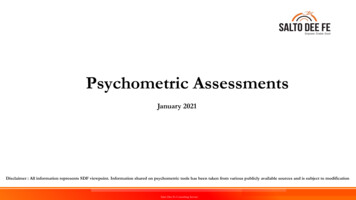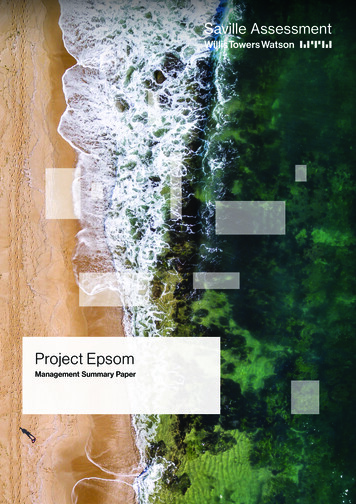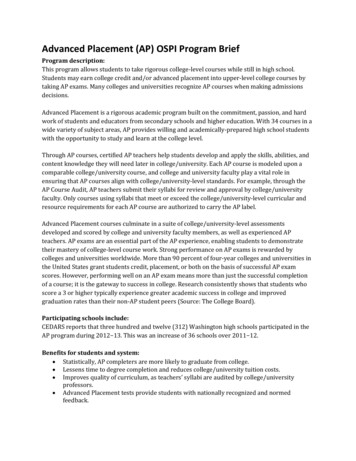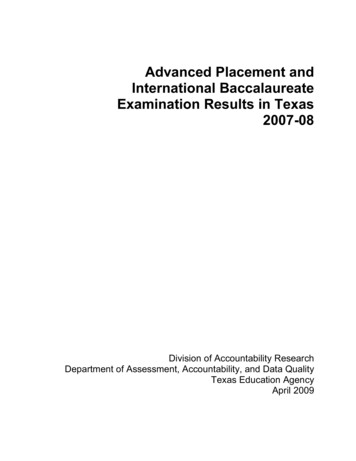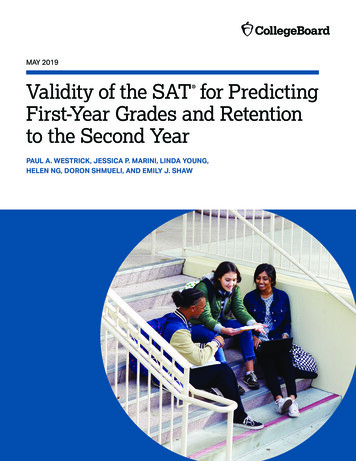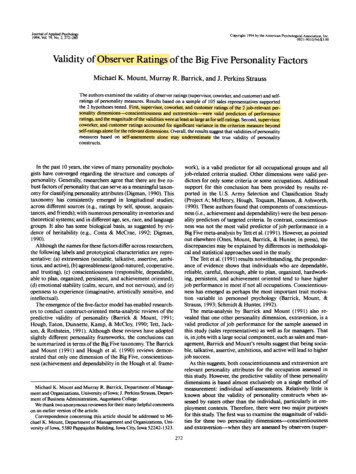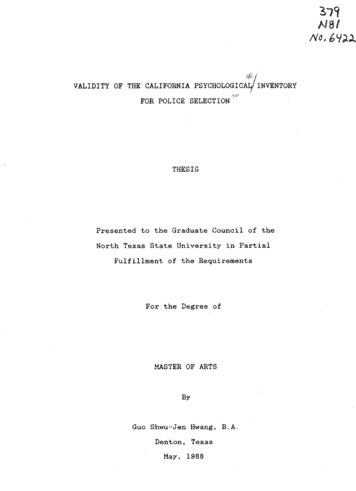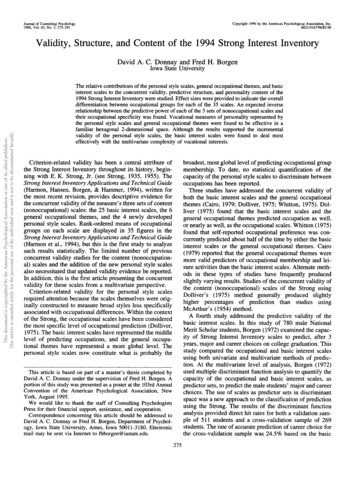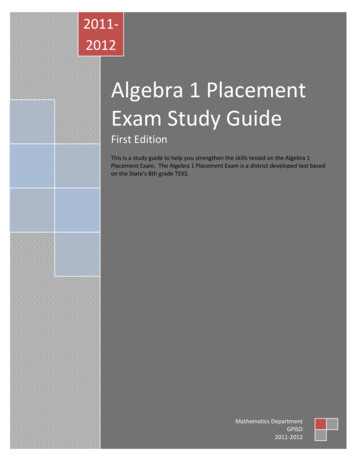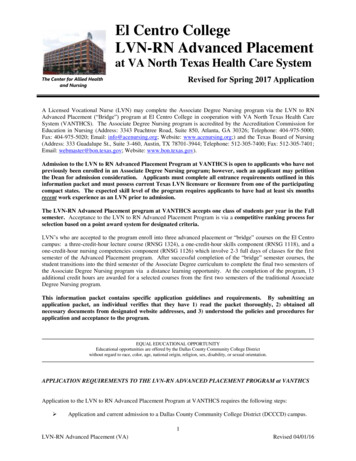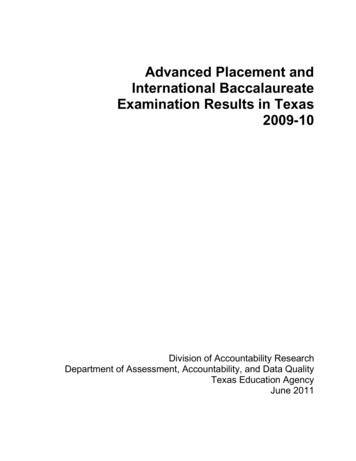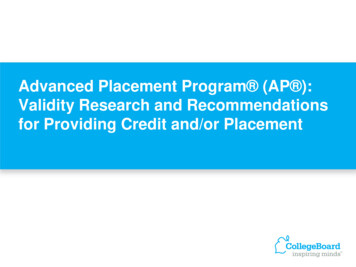
Transcription
Advanced Placement Program (AP ):Validity Research and Recommendationsfor Providing Credit and/or Placement
College Board’s Mission and Purpose The College Board is a not-for-profit membership association whosemission is to connect students to college success andopportunity. Founded in 1900, the association is composed of more than 5,600schools, colleges, universities and other educationalorganizations. Each year, the College Board serves seven million students andtheir parents, 23,000 high schools, and 3,800 colleges throughmajor programs and services in college admissions, guidance,assessment, financial aid, enrollment, and teaching and learning. The College Board is committed to the principles of excellenceand equity, and that commitment is embodied in all of its programs,services, activities and concerns.Source: http://www.collegeboard.com/about/index.html
AP MissionThe College Board’s Advanced PlacementProgram (AP ) enables students to pursuecollege-level studies while still in high school.Through more than 30 college-level courses,each culminating in a rigorous exam, APprovides willing and academically preparedstudents with the opportunity to earn collegecredit and/or advanced placement.
AP Overview Started in 1955 Rigorous college-level courses taught in highschools around the world Exam grades utilized for college credit and/orplacement Over 30 Advanced Placement exams in over 20subject areas World Languages expansion: Chinese and Japanese(2007)
Introduction to AP In 2008, students representing over 17,000 schools around the world, bothpublic and nonpublic, took AP Exams Enables students to pursue college-level studies while still in high school More than 30 college-level courses, each culminating in a rigorous exam Provides willing and academically prepared students with the opportunity toearn college credit and/or advanced placement Demonstrates to college admissions officers that students have sought out themost rigorous curriculum available to them Each AP teacher’s syllabus is evaluated and approved by college faculty fromsome of the nation’s leading institutions Exams developed and scored by college faculty and experienced AP teachers Accepted by more than 3,600 colleges and universities worldwide for collegecredit, advanced placement, or both on the basis of successful AP Exam gradesSource: http://www.collegeboard.com/html/aprtn/?excmpid CBF13-ED-1-aprtn
AP Courses Arts Art History, Music Theory, Studio Art(drawing, 2-D, 3-D)Mathematics and Computer Science English Language and Composition, Literatureand Composition Sciences History and Social Sciences Calculus AB, Calculus BC, ComputerScience A, *Computer Science AB,StatisticsBiology, Chemistry, EnvironmentalScience, Physics B, Physics C: Electricityand Magnetism, Physics C: MechanicsComparative Government and Politics, World LanguagesEuropean History, Human Geography,Macroeconomics, Microeconomics, Chinese Language and Culture, FrenchPsychology, United States GovernmentLanguage, *French Literature, Germanand Politics, United States History,Language, **Italian Language and Culture,World HistoryJapanese Language and Culture, *LatinLiterature, Latin: Vergil, SpanishLanguage, Spanish Literature* indicates courses that have been discontinued beginning in the 2009-2010 academic year** indicates course has been suspended beginning in the 2009-2010 academic yearSource: es/teachers corner/index.html
Who Participates in AP? 17,000 secondary schools worldwide offer APExams More than 122,000 AP teachers in nearly 15,000schools worldwide are authorized to teach APcourses In 2008, over 1.5 million students took about 2.7million exams 5,000 college faculty develop and score the APExams ensuring college-level standards 3,600 colleges receive AP Exam gradesannuallySource: http://www.collegeboard.com/html/aprtn/?excmpid CBF13-ED-1-aprtn
Faculty Involvement College faculty are involved in AP Course and Examdevelopment. Currently, faculty: Serve as Chairs and members of all AP Development Committees thatdevelop all AP course descriptions and exams Pre-test AP Exams by embedding them within exams offered in thecollege classroom Score the free-response sections of AP Exams by attending the APReading every June Are responsible for standard setting and are involved in the evaluation ofstudent responses at the AP Reading; the Chief Reader for each APsubject is a college faculty member Lead professional development workshops for new and experienced APteachers Serve as the senior reviewers in the annual AP Course Audit, ensuring APteachers’ syllabi meet the curriculum guidelines of college-level coursesSource: acement/ap/involved
What are College Faculty Saying aboutthe AP Experience?“We often observe a discernible differencebetween students without any AP experience, whotypically only devote a few hours to homeworkeach week, and AP students who have developedthe time management skills and the discipline todo the type of time consuming intellectual work(studying) that is required to be successful incollege.”Spencer A. BensonDirector Center for Teaching ExcellenceAssociate ProfessorDepartment of Cell Biology and Molecular GeneticsUniversity of Maryland, College Park
What do AP Exam Grades Represent?Each AP Exam grade is a weighted combination of thestudent's score on the multiple-choice section and on thefree-response section. The final grade is reported on a 5point scale:5 extremely well qualified4 well qualified3 qualified2 possibly qualified1 no recommendation AP grades of 5 and 4 are comparable to a college course grade ofA, while at some institutions, an AP grade of 4 is comparable to acollege course grade of B An AP grade of 3 is approximately equal to a college course gradeof B at many institutions, while at others it is more nearlycomparable to a college course grade of C.Source: acement/ap/exam/grades
College Comparability StudiesCollege comparability studies are used toset AP grades in order to ensure that theAP standards are comparable to or higherthan the grading standards that are appliedby college professors when evaluating theperformance of their own students incorresponding college courses.Source: es/11584.html
Comparability Study ParticipationFaculty at the following institutions have participated incomparability studies in recent years: Baylor University UCLA Brigham Young University UC-Berkeley Duke University University of Colorado-Boulder Grinnell College University of Maryland-College Park Harvard University UNC-Chapel Hill Michigan State University University of Pennsylvania Middlebury College University of Southern California Princeton University University of Virginia Purdue University University of Washington Smith College University of Wisconsin-Madison Stanford University Washington University in St. Louis Tufts University Yale University
Key Benefits of AP AP courses establish a college-level standard in secondary schoolsthat is measured through a national assessment designed and scoredby college faculty. AP courses expose college-bound students to the amounts ofhomework, study skills, and habits of mind essential for success incollege courses. AP provides leverage for aligning and strengthening the grades 6-12curriculum. Students who take AP Exams and score a 3 or higher typicallyexperience greater academic success and college graduation ratesthan non-AP students. The AP course is typically the most rigorous curriculum offered insecondary schools and is designated on the student transcript. Because AP is widely used for college credit and/or placement, itattracts motivated students eager to double major, or engage indeeper, upper-division courses at college.
Growth in Exam Grades of 3 and Higher AmongUnderrepresented Students: 2004-2008Source: SDRS 2004-2008*Percentages listed represent growth from 2004-2008
Equity and Excellence: Students Scoring3 or higher on AP Exams by StateSource: AP Report to the Nation 2009
AP Report to the Nation: How Does OhioCompare?Class of 2008 – Ohio 122,456*- HS studentsClass of 2008 – Nation 3.03million* - HS students 21,502- 757,932 17.6% 25.0% 10.8% 15.2%# of HS studentswho took an AP examtook an AP examwhile in HSearned a score of 3or higher*Public school numbers (Source: WICHE, 2008)- # of HS studentswho took an AP examtook an AP examwhile in HSearned a score of 3or higher
AP Research
TIMSS Advanced Mathematics andPhysics TestsEugenio J. Gonzalez, Kathleen M. O'Connor, & Julie A. Miles (2001) Gonzalez et al showed that students enrolled in AP Calculus coursesearned the highest average scores on the TIMSS AdvancedMathematics tests, significantly outperforming students in all othercountries, including U.S. students who did not take AP Calculus. Students enrolled in AP Physics also performed well, scoringsignificantly above the international average on the TIMSS Physicstest; whereas U.S. students not taking AP scored significantly belowthe international average. It's also important to note that AP studentswho earned AP Exam grades of 3 or better on the AP Calculus Examsor the AP Physics Exams earned even higher scores on the TIMSSassessments compared to students who took the AP course but notnecessarily the exam.Source: Gonzalez, E., O’Connor, K., & Miles, J. (2000). How well do Advanced Placement students perform on theTIMSS Advanced Mathematics and Physics Tests? Chestnut Hill, MA: The International Study Center, Lynch School ofEducation, Boston College.
AP Student Performance in Physics While the U.S. lags behind industrialized countries that participate in theTIMSS test, AP physics students who earned exam grades of 3 or higheroutscore all other students. Students who earned a 1 or 2 on AP Physics Exams outscored students inmore than half of participating industrialized countriesSource: Gonzalez, E., O’Connor, K., & Miles, J. (2000). How well do Advanced Placement students perform on theTIMSS Advanced Mathematics and Physics Tests? Chestnut Hill, MA: The International Study Center, Lynch School ofEducation, Boston College.
AP Student Performance in Math While the U.S. lags behind nearly every industrializedcountry that participates in the TIMSS test, AP calculusstudents, regardless of exam grade, outscored all otherstudentsSource: Gonzalez, E., O’Connor, K., & Miles, J. (2000). How well do Advanced Placement students perform on theTIMSS Advanced Mathematics and Physics Tests? Chestnut Hill, MA: The International Study Center, Lynch School ofEducation, Boston College.
Morgan and Klaric*: College SuccessAmong AP and Non-AP Students Nationwide 2007 study that built on similar studyfrom 1998 Collected official student transcript data fromnumerous colleges and universities Compared sequent course grades of AP studentsand non-AP students Examined trends in course-taking Looked at underrepresented students majoring inscience, technology, engineering, andmathematics (STEM)*The 2007 study conducted by Morgan and Klaric was a follow up to a 1998 study by Morgan and Ramist.
Morgan and Klaric: ParticipatingColleges* Barnard College Texas A&M University Binghamton University University of California – Davis** Brigham Young University** University of California – Los Angeles Carnegie Mellon University** University of Florida College of William and Mary** University of Illinois – Urbana** Cornell University** University of Iowa Dartmouth College University of Maryland George Washington University University of Miami Georgia Institute of Technology University of Southern California Miami University (Ohio) University of Texas at Austin** North Carolina State University University of Washington Northwestern University Wesleyan College Stanford University** Williams College*Institutions listed are those that participated in the 2007 study**Indicates institutions that participated in both the 1998 and 2007 studies
Morgan and Klaric: Grade Point Averages of APand Non-AP Students AP students whoscored a 3 or higheron AP Examsoutperformed matchednon-AP studentsSource: Morgan and Klaric, 2007
Morgan and Klaric: Trends in Course TakingSource: Morgan and Klaric, 2007
Morgan and Klaric: Underrepresented StudentsMajoring in STEM DisciplinesSource: Morgan and Klaric, 2007
Hargrove, Godin, and Dodd: CollegeOutcomes Among Three Student Groups 2007 statewide study of public four-year institutions inTexas Provides an extensive comparison of students’performance on several college outcomes (first andfourth-year GPA and 4-year graduation status) amongthree groups: Students who took the AP course and exam Students who took only the AP course Students who took standard high school courses but not APControls for SAT scores and SES (as measured byFree or Reduced Price Lunch status)Source: Hargrove, Godin and Dodd,2008
Hargrove, Godin and Dodd: Results The “AP course and exam” group significantlyoutperformed the “standard high school courses”group on all college outcomes in all years, afterstatistically controlling for SAT scores and SES. The “AP course and exam” group alsosignificantly outperformed the “AP course only”group on all college outcomes.Source: Hargrove, Godin and Dodd, 2008
Hargrove, Godin and Dodd: College GradePoint Averages AP students whoscored a 1 on APExams outperformedstudents who hadtaken neither AP nordual enrollment AP students whoscored a 2 or higheron AP Examsoutperformed allstudentsSource: Hargrove, Godin and Dodd, 2008
Time to DegreeStudents who scored a 3or higher on an APExam were more likelythan other students toearn a bachelor’sdegree within 4 years.Source: Hargrove, Godin & Dodd (2008)
Dougherty, Mellor and Jian: Time toGraduation 2006 statewide study in Texas Followed a cohort of students from 1994 (8thgrade) to 2003 (five years after enrolling incollege) Students who were enrolled in public collegesand universities in Texas Focused on likelihood of students graduating fromcollege within five years of enrollingSource: Dougherty, Mellor and Jian, 2006
Dougherty, Mellor and Jian: Results AP students who were exempted from theintroductory course generally did at leastas well, if not better, in the subsequentcourse as those who took the introductorycourse Students who score a 3 or higher on an APExam are more likely to graduate fromcollege in five years or less compared tonon-AP studentsSource: Dougherty, Mellor and Jian, 2006
Dougherty, Mellor and Jian: ResultsCollege Graduation Rate differences between “matched” AP and non-AP students*Student DemographicAP Exam Grade of3 or higherAfrican-American28% higherHispanic28% higherWhite33% higherLow-Income26% higherNot Low-Income34% higher*Students who scored a 3 or higher on AP ExamsSource: Dougherty, Mellor and Jian, 2006
AP and College Success Research continues to suggest that AP Exam grades of 3or higher are consistently predictive of student collegesuccess Emphasis should be on strong partnerships between K12, higher education, states and College Board to helpmore students earn grades of 3 or higher College Board believes that willing and academicallyprepared students should be encouraged and supportedin taking on the challenge of college-level courses in highschool Students may experience college success regardless ofexam grade
Sources College Board / AP Program AP Report to the Nation 2009 College Board Staff Data Resource Software (SDRS) Dougherty, Chrys, Lynn Mellor and Shuling Jian. 2006. The Relationship Between AdvancedPlacement and College Graduation. 2005 AP Study Series, Report 1. National Center forEducational Accountability. Gonzalez, E., O’Connor, K., & Miles, J. (2000). How well do Advanced Placement students performon the TIMSS Advanced Mathematics and Physics Tests? Chestnut Hill, MA: The International StudyCenter, Lynch School of Education, Boston College. Organisation for Economic Co-Operation and Development (OECD) 2003 Programme for International Student Assessment (PISA) 2006 database *Morgan, Rick and John Klaric. 2007. AP Students in College: An Analysis of Five-Year AcademicCareers. Research Report No. 2007-4. The College Board: New York, NY. *Hargrove, Linda, Donn Godin and Barbara Dodd. 2007. College Outcomes Comparisons by AP andNon-AP High School Experiences. Research Report No. 2008-3. The College Board: New York, NY.* Available on collegeboard.com/research
The College Board's Advanced Placement Program (AP ) enables students to pursue college-level studies while still in high school. Through more than 30 college-level courses, each culminating in a rigorous exam, AP provides willing and academically prepared students with the opportunity to earn college credit and/or advanced placement.
